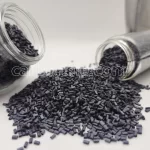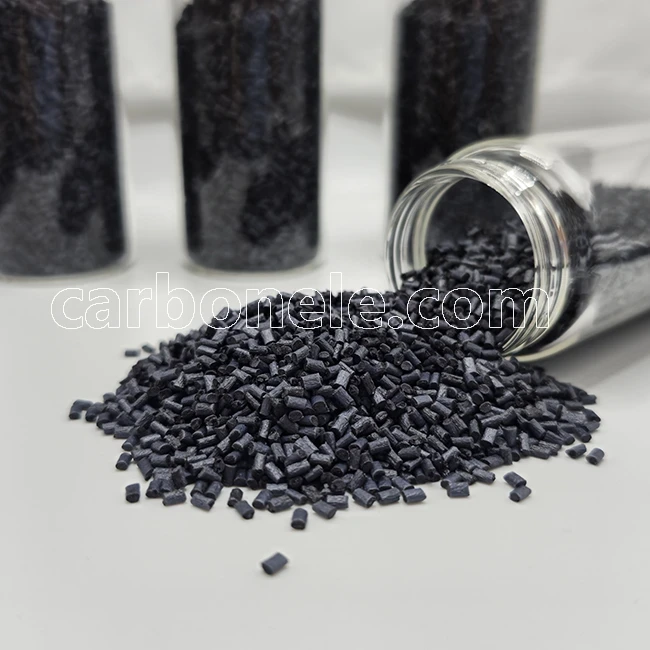
Virgin PBT CF50 PBT-CF 50% Carbon Fiber Reinforced PBT Raw Materials
PBT-CF 50 has high strength to withstand heavy loads, good rigidity for stability, heat resistance for use in moderately high temps, low thermal expansion, chemical resistance and is lightweight yet strong, making it ideal for many industrial applications.
- Manufacturer: Carbon New Material
- OEM/ODM: Acceptable
- Color: Black
- Free samples: ≤10kg
- MOQ: 100kg
- Port: Xiamen
- Matrix Resins: PBT-CF-BCA5
PBT CF50 is one of the many series of products of PBT-CF. PBT-CF is a composite material composed of polybutylene terephthalate (PBT) matrix and carbon fiber. It has characteristics such as high strength, rigidity, heat resistance and dimensional stability, and is widely used in fields such as electronics, automobiles, and machinery.
The “50” in PBT CF50 usually represents a carbon fiber content ratio of 50%. Compared with other PBT-CF products, PBT CF50 performs better in mechanical properties due to its higher carbon fiber content, with higher strength and rigidity. At the same time, it may also have further improvements in heat resistance, dimensional stability and other aspects.
PBT CF50 is a specific product in the PBT-CF series, with more prominent performance to meet application scenarios with higher requirements for material properties.
What’re the advantges of PBT-CF 50 composites?
1. High strength: The incorporation of carbon fiber gives PBT CF50 significantly enhanced strength, enabling it to withstand heavy loads and stresses.
2. Good rigidity: It has excellent rigidity, ensuring stability and resistance to deformation.
3. Heat resistance: PBT-CF50 can operate in moderately high temperature environments without significant degradation.
4. Low thermal expansion: Reduces dimensional changes due to temperature fluctuations.
5. Chemical resistance: Resistant to many chemicals, suitable for various industrial applications.
6. Lightweight yet strong: Offers a good combination of strength and low weight, beneficial for applications where weight reduction is important.
Case Sharing
A car manufacturing company that has long cooperated with Carbon (Xiamen) New Material has been looking for a material that can meet both high-strength requirements and reduce weight to manufacture engine hoods. After extensive research and testing, they chose the PBT CF50 composite material produced by Carbon Xiamen New Material.
PBT-CF 50 brings many advantages to this part. Its high-strength characteristic enables the engine hood to withstand vibrations and impacts under various road conditions, ensuring the safety of the engine. Even if there is a bump or a small collision at high speed, the engine hood will not be easily deformed or damaged.
The good heat resistance performs outstandingly in the high-temperature environment of the engine. It can withstand the heat emitted by the engine without softening or performance degradation, maintaining the stability and reliability of the part.
The low-weight characteristic of PBT-CF50 contributes to the overall weight reduction of the car. This not only improves the fuel efficiency of the car but also enhances the handling performance of the car.
During the production process, CF50-PBT also shows good processability. Through advanced injection molding technology, high-quality engine hood parts can be produced quickly and efficiently, reducing production costs and production cycles.
The engine hood parts manufactured by this car manufacturing company using PBT CF50 have achieved great success in the market. Consumers have highly praised the performance and quality of the car. At the same time, the company has also occupied a more favorable position in the highly competitive car market. This success case provides a good reference for other car manufacturers and related industries, showing the great potential of CF50 PBT in high-performance product manufacturing.
Composites of carbon fiber reinforced thermoplastic produced by various manufacturers have different focuses on performance. Meanwhile, the performance of carbon fiber modified thermoplastic composites will differ due to factors like different matrix resins, carbon fiber content and types, as well as production processes.
If you are intrigued by this material and wish to know more about information such as product specifications, performance and price, please get in touch with us directly.
Contact Us
If you are intrigued by this material and wish to know more about information such as product specifications, performance and price, please get in touch with us directly. Thank you.

Frequently Asked Questions
Carbon (Xiamen) New Material Co., Ltd. aims to provide buyers with "one-stop" worry-free high-quality services. Here you can find all information about carbon fiber engineering plastics. If you still have questions, please send us an email for consultation!
-
How can I contact the manufacturer of a product that interests me?
When you find a product you are interested in, you can contact the manufacturer directly by sending an email and we will get back to you as soon as possible.
-
How do I find the products that interest me?
All you need to do is enter the keyword, product name in the search window and press the Enter key on your keyboard. Your search results page will then be displayed. You can also search within the product category pages on the home page. Each category is divided into subcategories, allowing you to refine your search and find products that interest you.
-
Where will I find a buying guide?
Please contact our after-sales service directly and we will provide you with a comprehensive operating guide.
-
What are CF Reinforced Thermoplastic Composites?
CF Reinforced Thermoplastic Composites are materials where carbon fibers are incorporated into a thermoplastic matrix. They combine the strength and stiffness of carbon fibers with the processability and recyclability of thermoplastics. For instance, they are used in automotive parts like bumper beams.
-
What are the benefits of CF Reinforced Thermoplastic Composites over traditional composites?
The key benefits include faster production cycles, easier recyclability, and better impact resistance. They also offer design flexibility. An example is in the manufacturing of consumer electronics casings where complex shapes can be achieved more easily.
-
How are CF Reinforced Thermoplastic Composites processed?
Common processing methods include injection molding, extrusion, and compression molding. Injection molding is widely used for mass production. For example, in the production of small components for the medical industry.
-
What industries use CF Reinforced Thermoplastic Composites?
They are utilized in aerospace, automotive, medical, and sports equipment industries. In aerospace, they can be found in interior components. In the medical field, they might be used in prosthetics.
-
How does the carbon fiber content affect the properties of the composites?
Higher carbon fiber content generally leads to increased strength and stiffness but may reduce ductility. A moderate content is often balanced for specific applications. For example, a higher content might be preferred in structural parts of a race car.
-
What are the challenges in using CF Reinforced Thermoplastic Composites?
Challenges include higher material costs, complex processing equipment requirements, and ensuring uniform fiber dispersion. Issues with adhesion between the fibers and the matrix can also arise. An example is in achieving consistent quality in large-scale production.























